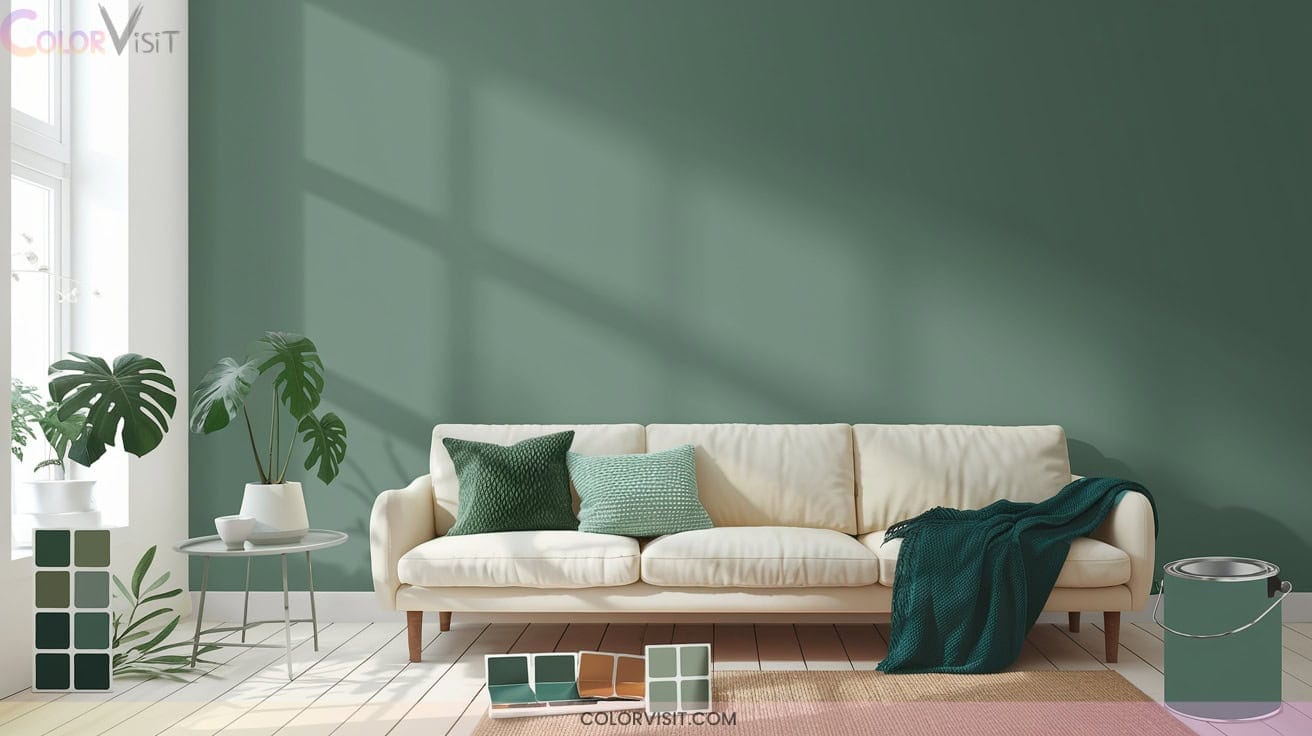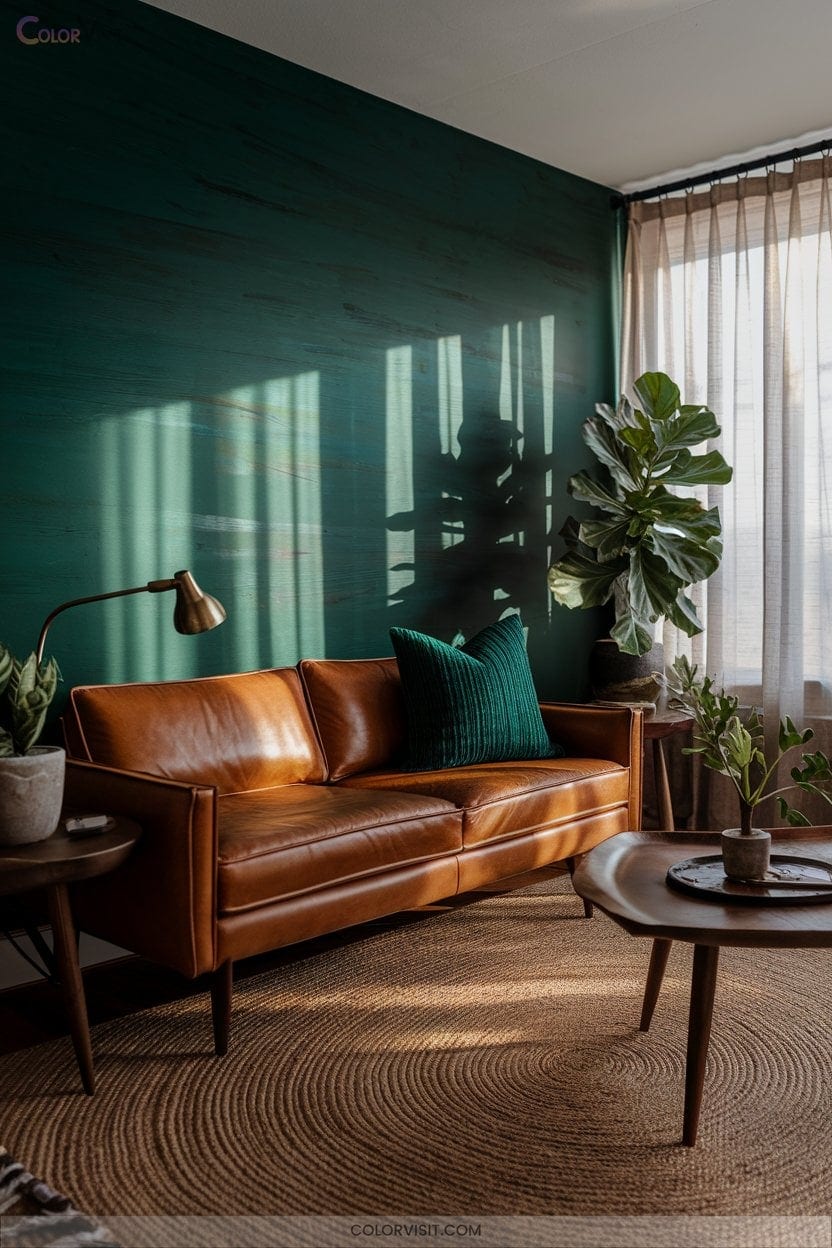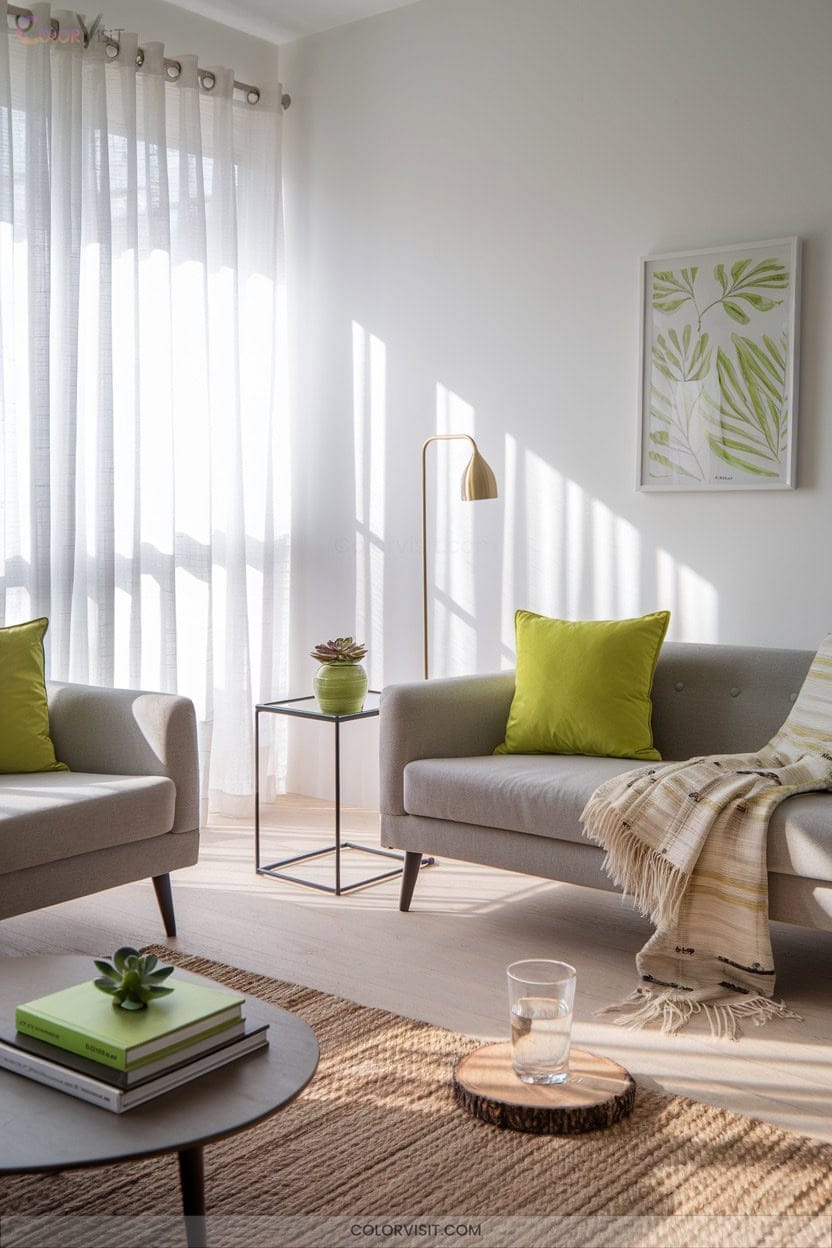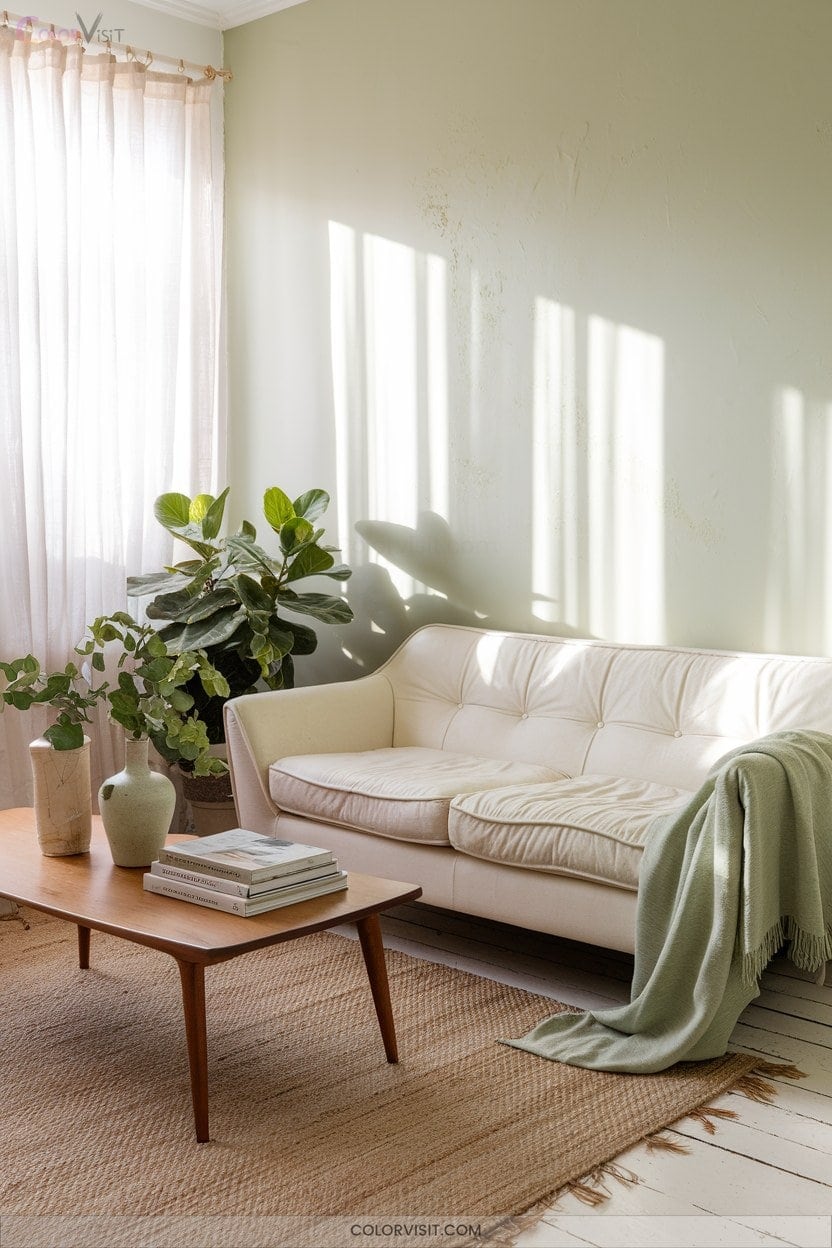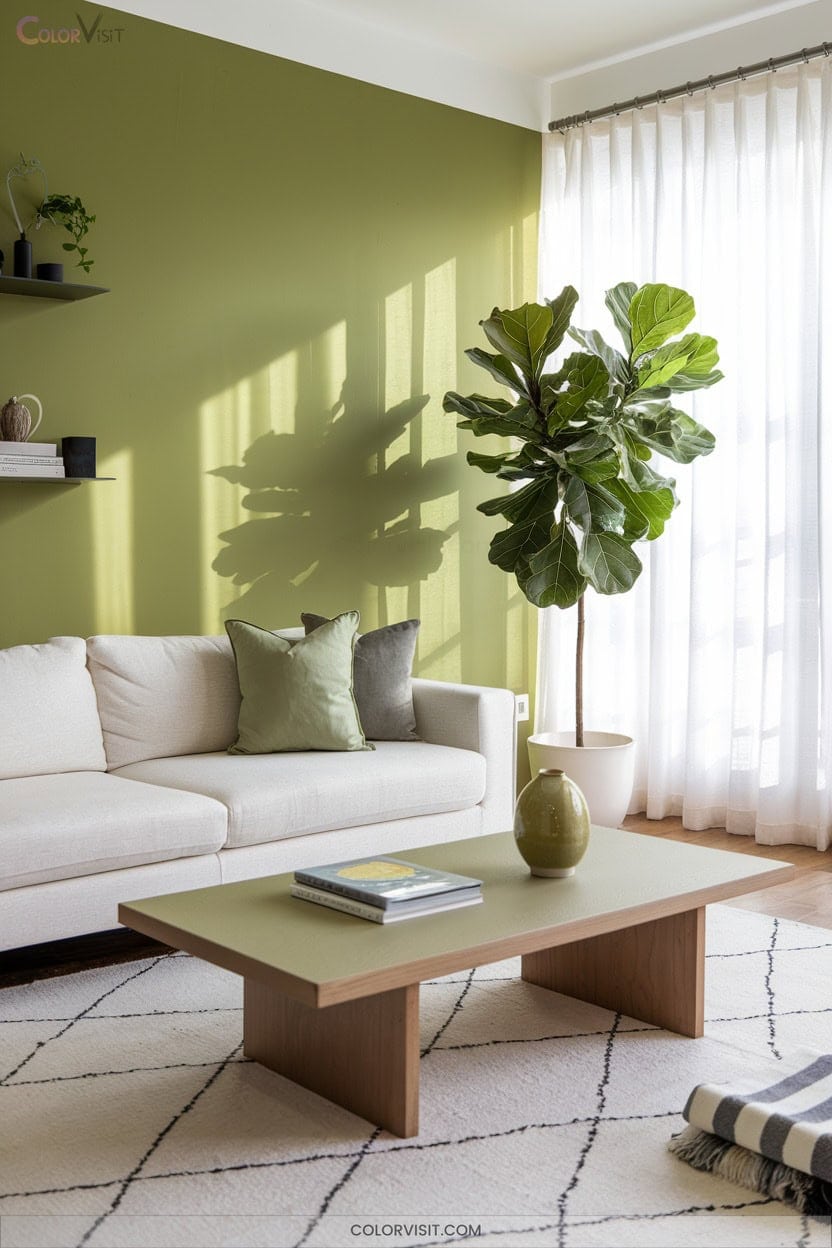16 Refreshing Green Wall Color Ideas to Bring Nature Indoors
Infuse your space with green wall colors that bring organic calm and modern vibrancy indoors.
Try soft olive or sage for muted, biophilic harmony, or opt for moody emerald, pine, or dark forest greens to add dramatic, on-trend depth.
Eucalyptus, pistachio, and mint offer fresh, minimalist clarity, while lively key lime and chartreuse accents energize contemporary rooms. Pair celadon or basil with light neutrals for chromatic balance. Explore bold palettes and nuanced layering for even more transformative ideas.
1. Soft Olive Green
Soft olive green introduces a muted, warm hue that blends yellow and green, delivering a soothing, nature-inspired aesthetic to interiors.
You’ll notice its subtle hex profile around #BAB86C, though lighter tints echo contemporary trends.
This shade radiates calm, channeling the tranquility of forests and fields, while its light absorption produces a cozy ambiance ideal for both modern and traditional spaces.
Pair it with organic textures, natural wood, and earthy tones to enhance its authenticity.
Accent walls or textiles in soft olive green cultivate depth and serenity, supporting creativity and balance.
It’s a versatile choice for innovative, biophilic design.
2. Refreshing Mint Green
While olive green offers a grounded, earthy ambiance, mint green infuses spaces with a crisp, invigorating energy.
This hue, inspired by nature’s freshness, introduces tranquility and visual clarity to any interior.
A shade born from nature’s vitality, mint green brings calming clarity and a refreshing sense of peace to any room.
Pair mint green with white for a minimalist, luminous effect or black for a high-contrast, contemporary statement.
Integrate wooden textures to add warmth, or experiment with metallic accents for an avant-garde edge.
Mint green’s versatility suits both modern and traditional spaces—ideal for bedrooms, kitchens, or bathrooms. Layer different shades or combine with pastels for depth.
Embrace mint green to create a trend-forward, serene sanctuary that feels perpetually renewed.
3. Moody Emerald
A moody emerald wall instantly transforms any interior into a lush, sophisticated retreat.
Lean into the depth of Topsoil or Jasper for a dramatic, immersive effect—these rich greens evoke dense foliage and serene woodland vibes.
To elevate the look, balance the saturated hue with natural textiles and strategic accent lighting, letting the color’s complexity shine.
Pair moody emerald with dark woods or metallic accents for a luxurious, trend-forward aesthetic.
This shade’s organic undertones foster calmness and creativity, making it ideal for both restful and inspiring spaces.
For added dimension, layer in textured throws and bold-patterned accessories.
4. Sage Green
Serenity defines sage green, a muted, earthy shade with subtle gray undertones that brings an effortless calm to any space.
As a new neutral, sage green adapts seamlessly to minimalist interiors, ranch-style homes, or Parisian-inspired kitchens. Pair it with beige, rust, or brass hardware for a curated, modern palette.
Sage green truly excels as both an accent wall and a dominant color, its chromatic versatility enhanced by natural or layered artificial lighting.
Despite a shift toward vibrant jewel-toned greens, sage green endures—its sustainable, nature-connected vibe remains timeless, making it essential for forward-thinking, eco-conscious interior innovation.
5. Dark Forest Green
Forest-inspired palettes set the tone for dark forest green—a deep, moody hue that’s dominating 2024 design trends for its balance of drama and calm.
When you’re seeking a sophisticated yet tranquil atmosphere, this shade excels with its lush, nature-driven aesthetic. Maximize its impact by considering these technical strategies:
Dark forest green anchors 2024 design, offering lush sophistication and a calming, nature-inspired mood for truly dramatic interiors.
- Illuminate with layered lighting to counteract the low LRV and prevent spaces from feeling closed in.
- Pair with neutral backdrops or metallic accents to highlight its depth and saturation.
- Integrate organic textures—think wood, linen, or stone—for layered warmth and visual complexity, keeping your space both innovative and inviting.
6. Earthy Olive Grove
Shifting from the depth of dark forest green, olive green offers a grounded, earthy palette that brings the tranquility of nature indoors.
Embrace its versatility—use olive green as an accent wall or envelop a space in monochromatic harmony.
Pair it with natural materials like oak or travertine for organic sophistication. Integrate olive-toned sofas, textiles, and curated decor for tactile depth.
Seek inspiration from Tuscan landscapes or merge with boho-industrial elements for a fresh narrative.
This shade’s biophilic roots foster calm, growth, and balance, making it ideal for innovative home offices, serene bedrooms, or rustic-inspired living rooms seeking timeless appeal.
7. Key Lime Accents
Citrus-charged color schemes infuse interiors with vibrancy, and key lime accents deliver a jolt of optimistic energy that instantly refreshes any space.
This zesty hue energizes your environment, offering both a modern edge and a connection to nature.
To maximize aesthetic impact, consider these innovative strategies:
- Layer key lime with turquoise or azure for a balanced, dynamic palette that feels both fresh and sophisticated.
- Use lime as accent pieces—side tables or decor—to create focal points and boost visual interest.
- Integrate neutrals to ground the intensity and maintain a harmonious, uplifting atmosphere.
8. Seafoam Green
While key lime electrifies with its bold vibrancy, seafoam green introduces a soothing balance that’s both modern and timeless.
With hex codes like #93E9BE and #9FE2BF, this soft green-blue shade delivers tranquility and subtle sophistication.
Seafoam’s RGB and CMYK values create a calming palette, harnessing high brightness with muted saturation for a fresh, healthful vibe.
Pair it with neutrals or pastels to amplify serenity and spatial harmony.
Its gray undertone sets it apart from mint, spring, or sea greens, making it perfect for innovative interiors, digital design, or nostalgic textiles.
Embrace seafoam green to cultivate calm, youthful energy.
9. Hunter Green
Hunter green infuses interiors with a grounded, sophisticated energy that echoes lush forests and timeless elegance.
This deep, rich shade is a rising favorite among design innovators for its ability to merge tranquility with contemporary flair.
Hunter green seamlessly blends serene vibes with modern sophistication, making it a top choice for forward-thinking interior design.
You can leverage hunter green’s versatility across various aesthetics by integrating tactile finishes and contrasting elements.
For a dynamic, trend-forward space:
- Use hunter green as a feature wall with textured paneling for depth.
- Pair with brass fixtures and light wood for refined contrast.
- Anchor with neutral textiles, letting the green radiate a calming, natural ambiance that feels both fresh and enduring.
10. Pastel Pistachio
A pastel pistachio wall introduces a revitalizing softness that’s both soothing and on-trend, offering a gentle alternative to bolder greens.
You’ll find options like Palest Pistachio 2122-60—subtle with crisp blue undertones—or Pistachio 561’s retro, yellowish-green character.
With an LRV around 68.65, this palette brightens spaces while maintaining a calming, nature-inspired vibe.
Pair it with contemporary white trims (White Dove OC-17), blush pink, or luxe gold accents for a fresh, innovative edge.
Pastel pistachio transforms bedrooms, kitchens, or home offices, especially when combined with light hardwood, mid-century furniture, and botanical prints for a sophisticated, organic statement.
11. Mossy Green
If you’re drawn to greens that feel grounded and timeless, mossy green offers a sophisticated alternative to pastel pistachio’s airy brightness.
This earthy, olive-tinged hue brings an authentic connection to nature, favored by designers for its calming, organic depth.
Mossy green delivers a tranquil, nature-inspired ambiance, prized by designers for its soothing, organic richness.
Mossy green’s versatility transforms interiors, harmonizing beautifully with natural textures and contemporary materials.
For innovative, aesthetic-driven application, consider:
- Accent walls in eggshell or satin finish for a velvety, light-reflecting effect.
- Cabinets or trim paired with bronze hardware for tactile contrast.
- Layering with beige, taupe, or muted blue to keep spaces serene yet visually inventive.
12. Chartreuse Accents
Vivid energy defines chartreuse accents, infusing interiors with a punchy, on-trend vibrancy that designers covet for modern spaces.
You can create visual drama by painting a feature wall chartreuse, or select standout furnishings—think sculptural armchairs or bold ottomans—for instant impact.
Integrate chartreuse through throw pillows, ceramics, or kitchen cabinetry for an innovative refresh.
Pair with neutrals like white or taupe to ground the look, or contrast with deep navy and black for a dynamic palette.
Layering chartreuse with other greens and organic textures channels biophilic design, ensuring your space feels both invigorating and deeply connected to nature.
13. Eucalyptus Green
Where chartreuse electrifies a room with bold vibrancy, eucalyptus green offers a more grounded, tranquil sophistication.
This muted, blue-toned green draws inspiration from the eucalyptus tree’s foliage, combining subtle silver and grey undertones for a serene, rejuvenating ambiance.
You’ll find eucalyptus green ideal for cultivating a rejuvenating, nature-inspired environment aligned with contemporary design trends.
To leverage its full potential:
- Pair with neutral palettes and organic textures for a harmonious, tactile experience.
- Utilize alongside botanical accents to amplify biophilic appeal.
- Apply in spaces requiring mental clarity—think creative studios or restful retreats—for an innovative, restorative atmosphere.
14. Pine Green
Pine green anchors a space with its deep, earthy essence—an homage to the enduring vigor of evergreen forests.
Elevate your interiors with this shade, which blends approximately 47% green and 44% blue for a rich, grounded effect (hex #01796F).
Blending 47% green and 44% blue, pine green (hex #01796F) brings a lush, grounded richness to any interior.
Its high saturation and low lightness offer striking depth, ideal for accent or feature walls.
Designers embrace pine green for its symbolism of renewal, stability, and harmony—qualities sought after in contemporary, biophilic spaces.
Pair it with light neutrals for crisp contrast, or integrate sustainable materials for an eco-forward look.
Let pine green infuse your space with tranquil, innovative energy.
15. Celadon Green
A subtle luminescence defines celadon green—a muted pastel rooted in the spring green spectrum, instantly recognized by its grayish undertones and blue-green blend.
You’ll find its #A8DCAB hex code on trend-driven palettes, prized for its serenity and cerebral clarity.
Celadon’s ceramic legacy now inspires modern interiors and digital design, offering an airy, focused environment.
For maximum impact:
- Pair with linen or oatmeal neutrals for fresh contrast.
- Use in productivity zones—study nooks or digital dashboards—for psychological balance.
- Test accessibility via WCAG tools, ensuring legibility against off-whites or warm grays.
Celadon green embodies understated innovation.
16. Basil Green
Basil green channels the tranquility of deep foliage, infusing interiors with a calm, nature-inspired vibe defined by its blue-gray undertones and softened luxury.
This on-trend hue, exemplified by Benjamin Moore’s 2029-10, delivers a rich yet airy presence, embodying biophilic design principles and sustainable energy.
Pair it with cool neutrals—crisp whites or silvery grays—for modern contrast, or integrate natural materials like oak and linen for tactile depth.
Basil green excels on feature walls, cabinetry, or in wellness-focused spaces, promoting focus without overwhelming. For innovation, use low-VOC formulas and virtual consults.
Complement with white blooms or indoor herb gardens for synergy.
Frequently Asked Questions
What Paint Finishes Work Best for Green Accent Walls?
You’ll want to select matte or eggshell finishes for a sophisticated, organic vibe, while satin and semi-gloss elevate green’s depth and vibrancy. Embrace gloss for bold, contemporary drama—just make sure your wall prep is flawless to avoid imperfections.
How Can I Prevent Green Walls From Looking Dated Over Time?
Think of your green wall as a living canvas—keep it timeless by phasing in textured botanicals, layering removable trellised vines, and rotating accent containers. Maintain a documented planting grid and use modular systems for seamless, future-proof refreshes.
Are Green Wall Colors Suitable for Homes With Low Natural Light?
You can absolutely use green wall colors in low-light homes—just choose shades with higher LRVs and nuanced undertones. Opt for soft sages or balanced greens; they’ll reflect light, feel contemporary, and create a biophilic, innovative atmosphere.
Which Green Shades Are Easiest to Maintain and Clean?
Over 60% of design pros recommend mid-tone, gray-green hues like “October Mist” (LRV 47) with an eggshell finish—they’re trend-forward, resist stains, and clean easily, so you’ll maintain that sophisticated look with minimal effort.
Can Green Walls Help Improve Mood or Productivity?
You’ll boost mood and productivity by installing green walls, leveraging biophilic design and visual stimulation.
Integrate diverse plant species and maximize natural light to enhance cognitive performance, motivation, and workplace satisfaction—aligning your space with cutting-edge wellness trends.
Conclusion
Bringing green onto your walls is like inviting a tranquil garden breeze indoors—effortlessly chic and endlessly soothing.
Whether you choose sage for its biophilic appeal or plunge into moody emerald for dramatic depth, these verdant hues infuse your space with fresh energy and on-trend sophistication.
Don’t be afraid to experiment with undertones or finishes; matte, eggshell, or glossy, each elevates the aesthetic. Embrace green’s versatility and watch your interiors flourish with modern, nature-inspired elegance.
